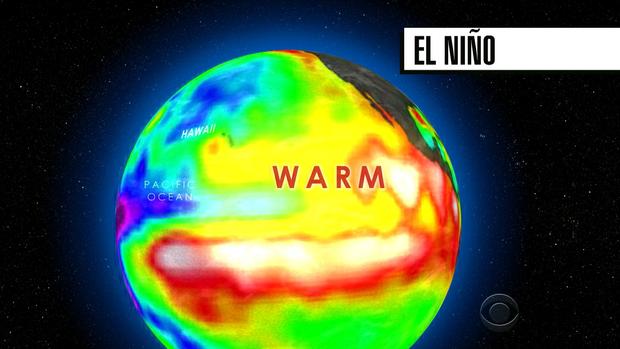Is an El Niño next in pattern of treacherous weather?
Rain Friday in Texas pushed Dallas to a new record for the month of May. More than 16 inches have fallen this month. That's about an inch-and-a-half short of the all-time record for any month in Dallas.
Oklahoma City has had almost 19 1/2 inches of rain -- making this the wettest month since they started keeping records 125 years ago.
Scientists say the floods could be a sign the weather-pattern known as El Niño is gaining strength in the Pacific. If so, California could finally get the drought-busting storms it desperately needs.
Tornadoes are tearing up the Plains. Texas is getting swamped by floodwaters. California is deep in drought. And now, a hurricane is forming in the Pacific.
The government's National Climate Assessment warns that "increases in the frequency and intensity of extreme precipitation events are projected for all U.S. regions."
Josh Willis, a NASA climate scientist, tells CBS News that in the past two years, scientists have seen a change in the jet stream that could be attributed to climate change. It often takes on a wavy pattern, causing more extreme weather - such as all that snow in Boston this past winter. Now, scientists are watching an El Niño rapidly grow in the Pacific Ocean.
Willis tells CBS News that while it's a bit early to say for sure, "this El Niño has all the markings of a big one."
"The cycle will continue throughout the year and peak sometime in the winter. So it could be Godzilla El Niño, but it could also be El Wimpo," he says.
An El Niño is caused by a band of warm ocean water in the Eastern Pacific. A satellite image taken this week shows it getting more intense.
"It can cause more water to evaporate and be carried over land, and eventually result in more storms and more rain," Willis says.
That's good news for parched California, which after four years of drought now needs at least 75 inches of precipitation to refill its near empty reservoirs.
The last large El Niño to hit the west was in 1998, when California saw record rain and mudslides.
El Niño-fueled storms caused more than 4 billion dollars in damage nationwide.
Southern California is already seeing some changes in weather compared to last May. This month has been unusually cool and wet. But nobody is counting their chickens just yet.
At this time last year, scientists were predicting a potential drought-busting El Niño and that one never happened.



